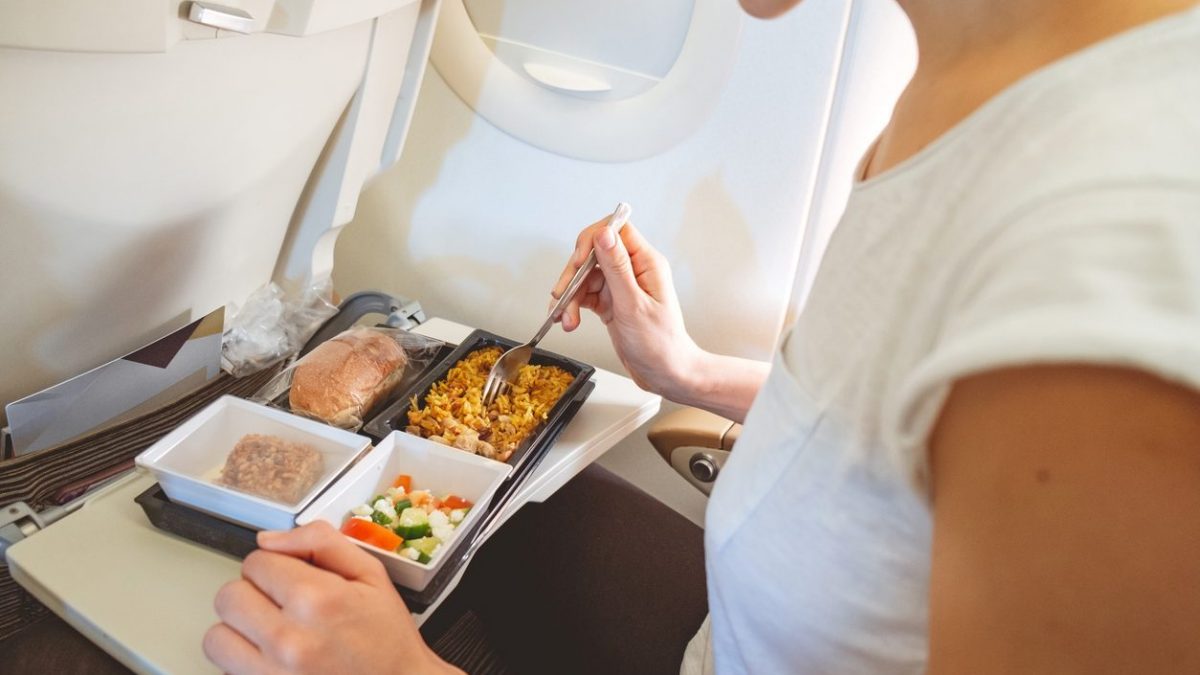
Chicken or beef? It's one of the questions that many of us have probably been asked at some point in our lives while sitting on an airplane, when it's time for a meal. And while most people are now accustomed to just a few (paid) snacks, especially on short-haul flights, it's the first and business class seats of major airlines that pamper their passengers on intercontinental flights just as they did in the 1950s and 1960s, the boom period of civil aviation when, as reported in a CNN article, the menu began with "beef consommé, continued with chicken breast cooked in wine and finished with a fruit tartlet for dessert." The experience of having lunch, dinner (and even breakfast) in the clouds is no longer an integral part of the journey as it once was, but at the same time it continues to be discussed, often in less than enthusiastic terms. So the question arises: why does food taste different —or rather, taste like nothing—when it's prepared and consumed thousands of kilometers above sea level? Let's try to provide some answers.
How is The Food Prepared and By Who?
The preparation of food served on board airplanes is an operation that requires particular attention and for this very reason it is handled by companies specialized in air catering, who work closely with the airlines to develop the menus: these must be guaranteed from a food safety point of view (having food poisoning in flight can prove to be a bigger problem to manage than when you are on the ground), easily transportable and, last but not least, pleasant.
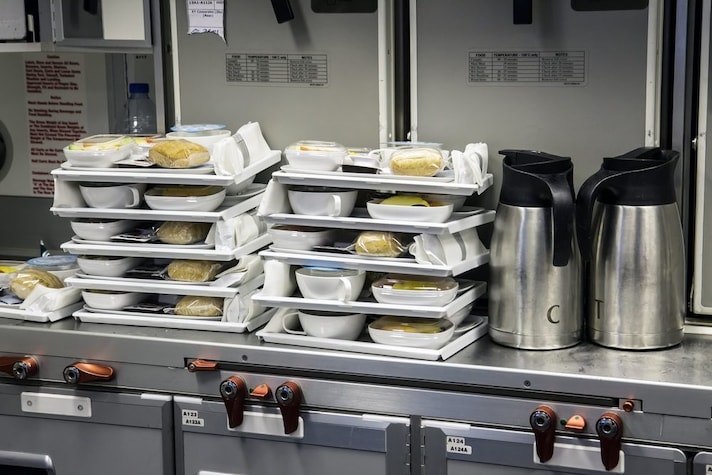
For this reason, many kitchens are located near airports and function as large production centers, where strict deadlines and high hygiene standards are adhered to: meals are typically prepared 8 to 24 hours before the flight, blast chilled, and then refrigerated for preservation. Dishes are then portioned, distributed in special containers, and loaded onto the plane shortly before departure. It's no secret that the quality and variety of food varies greatly depending on the airline and class: just consider that prestigious airlines may use pressurized chambers to simulate the in-flight experience when developing their menus, or that during the crossing, dishes created by Michelin-starred chefs, caviar, select wines, and champagne are offered.
How is The Meal Served on Board
When designing the menu, all the technical limitations encountered on board are taken into account: recipes can simply be reheated, as there is no kitchen on board. Food is stored in refrigerated trolleys until served. Staff (hostesses and stewards) are responsible for placing it in convection ovens (the most commonly used) or steam ovens, following the instructions so as not to alter the consistency and flavor. No microwaves are used for several reasons: aluminum or plastic, where food is traditionally stored, are materials not suitable for the appliance; electromagnetic waves could interfere with the technical equipment, and furthermore, heating is known to be uneven, posing potential health risks.
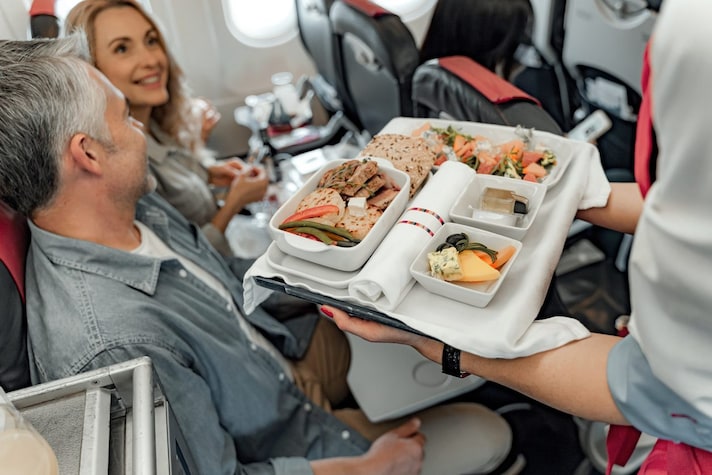
Generally, meals are organized in a practical way for both crew and passengers: this is why trays appear, containing all the dishes, which commonly on long-haul flights include an appetizer, a main course (meat, fish, or vegetarian), bread (with spreadable butter), dessert, and a fruit salad included in the fare. In business class or first class, the service can be similar to that of a restaurant, with courses presented individually, wine poured by the glass, and a refined table setting.
Why Does Airplane Food Taste Different?
If there's one detail about airplane food that everyone seems to agree on, it's its lack of palatability. While this is a flaw attributable to the nature of the dish itself, why does even a gourmet offering suffer the same negative judgment? The reason lies in the conditions in which meals are consumed in aircraft, which aren't exactly the same as those at sea level.
We can also notice this when we go up in the mountains: altitude has an effect on our sense of taste and smell, and it is estimated that when flying the perception of sweet and salty flavors (not sour or bitter ones) is reduced by up to 30%.
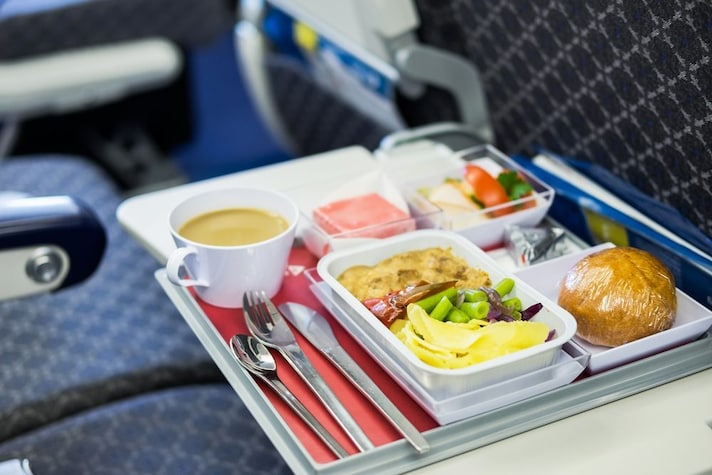
Furthermore, dry air dries out the mucous membranes, making the perception of aromas more complex: this is why recipes intended for airplanes are calibrated differently, with a more marked use of spices (such as curry), aromatic herbs and tomato, condiments that recall the umami, effective in breaking the monotony of a food that could otherwise appear bland and anonymous.
A Brief History of In-Flight Meals: From Luxury to Low Cost (and Back Again)
The combination of food and airplanes has existed practically since the dawn of civil aviation: among the first foods carried in the clouds was chewing gum, which was offered to passengers in the 1920s to help them "unclog their ears," as a solution to the common barotrauma caused by rapid changes in environmental pressure while in flight. In the 1930s, legendary airlines like Pan American Airways introduced hot meals, with the peak of in-flight dining reaching its peak in the 1950s and 1960s: in promotional posters of the time, it is not uncommon to see people eating at tables set with tablecloths as if they were in a luxury restaurant, precisely to signify how sharing food was one of the essential moments of flying.
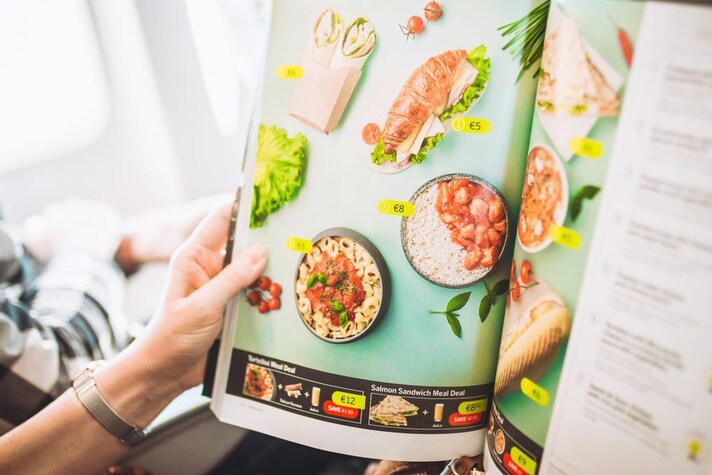
Things began to change with the deregulation of the American airline industry in the 1970s and 1980s : air travel became cheaper by cutting back on services previously considered status symbols, such as meals. Fast-forward to the present, and the attacks of September 11, 2001, marked another turning point, with increased security measures on board, including meal service, for example by banning the use of potentially dangerous utensils such as certain types of knives. Food safety also played a role, prohibiting the use of ingredients that pose a risk to allergies, such as peanuts, which had previously been extremely common. Furthermore, especially on low-cost airlines, costs were reduced by encouraging the creation of more seats and eliminating the space intended for reheating food: this is why cold dishes such as sandwiches and salads now appear on paid menus.
It must also be said, however, that the progressive decline in the quality of food served on airplanes in recent years has led to a real rediscovery of this pleasure (for those who can afford it) during travel: it was the French airline Air France that, in the 2010s, was the first to introduce the creations of Michelin-starred chefs to high-altitude flights. Similarly, Japan Airlines has partnered with chefs from Michelin-starred restaurants to offer gourmet meals in its First and Business Class cabins.
;Resize,width=767;)
